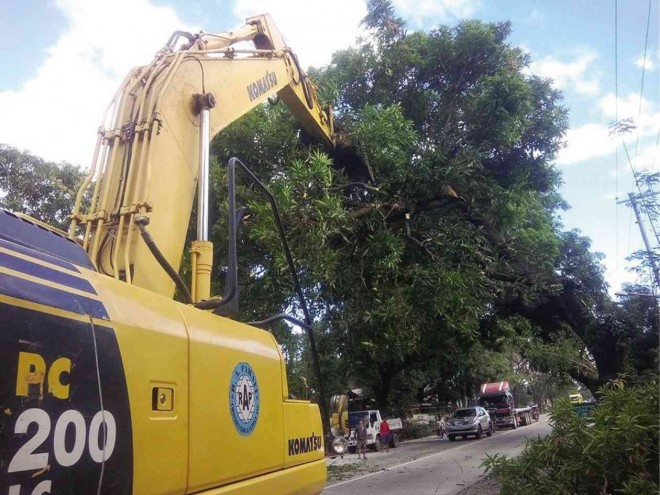Environmentalists question pruning of roadside trees

USING a backhoe and chainsaws, contractors of the Department of Public Works and Highways prune trees along the Manila North Road in Barangay Rosario in Pozorrubio, Pangasinan province. CONTRIBUTED PHOTO
DAGUPAN CITY—How does one prune or trim a tree?
This cropped up here after a contractor of the Department of Public Works and Highways (DPWH) chopped off branches of several trees along the Manila North Road (MNR) in Barangay Rosario in Pozorrubio town on Saturday and Monday.
Emmanuel Diaz, head of the DPWH’s engineering district, said the trees were being pruned of dead branches and those close to power transmission lines. But environmentalists and village residents thought otherwise.
In a post on Facebook, Ben Samalan, a resident of Rosario, said the DPWH contractor, Pahati Construction, left bald a 47-year-old mango tree fronting his house using a backhoe and chainsaw.
Samalan also posted a picture of at least three trees as they were being pruned by the contractor that day.
In a statement, Virginia Pasalo, founding executive director of the Women in Development Foundation, said the contractor’s way of pruning trees was to prepare them for cutting.
“[The contractor] cut away huge branches of flowering mango trees, and the pruned ones were hacked without mercy, that no one would think it was meant to be pruned, but prepared for its final end on the same day,” Pasalo said.
The pruned trees were among 770 trees that were left standing along the MNR after the DPWH’s tree cutting permit, issued in November 2013, expired in February 2014.
But 181 dead and dying trees were eventually felled in September. The trees did not survive after they were girdled, a process where a patch of bark around the tree trunk was removed to prevent nutrients from circulating within the tree.
The DPWH had applied for a new cutting permit but nongovernment organizations asked a court in Urdaneta City to issue a temporary environmental protection order to save the trees. The court is still hearing the case.
“We tried the next best measures to stop the carnage, but little could be done to a determined assassin riding on the power of his superiors, blatantly defying the law and the right of citizens to clean air and sustainable coexistence with the natural habitat,” Pasalo said.
Guideline
Under the guideline issued by Public Works Secretary Rogelio Singson on Sept. 3, 2014, trimming, pruning or cutting of trees should only be done by workers who are properly and sufficiently trained to do the job.
Trimming or pruning may be done either through crown thinning or crown raising, he said.
“Crown thinning reduces the size of the tree in order to rejuvenate growth. Hence, if thinning the crown is required, keep lateral branches as evenly spaced as possible especially on young trees,” the guideline said.
“To provide clearance for pedestrians, the crown should be raised by carefully pruning the tree. Live branches should be maintained on at least two thirds of the tree’s height,” it said.